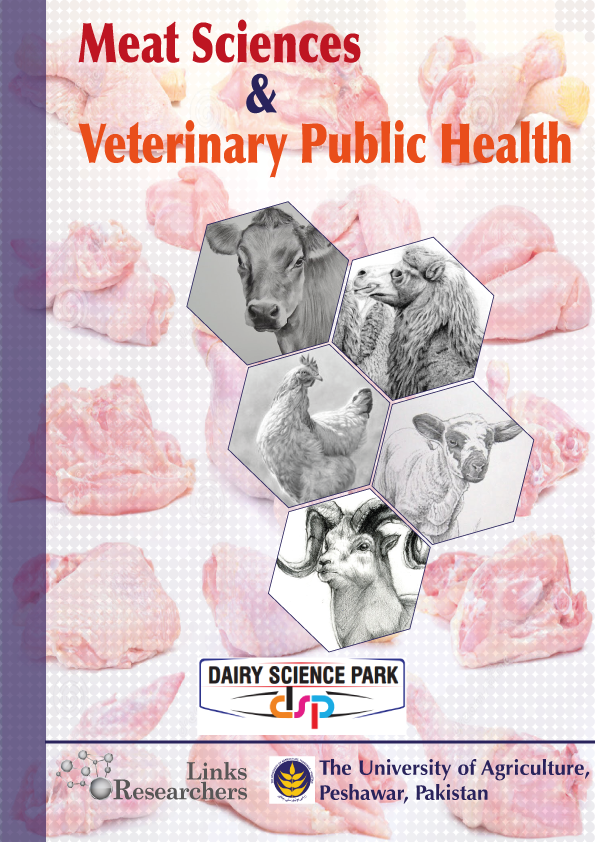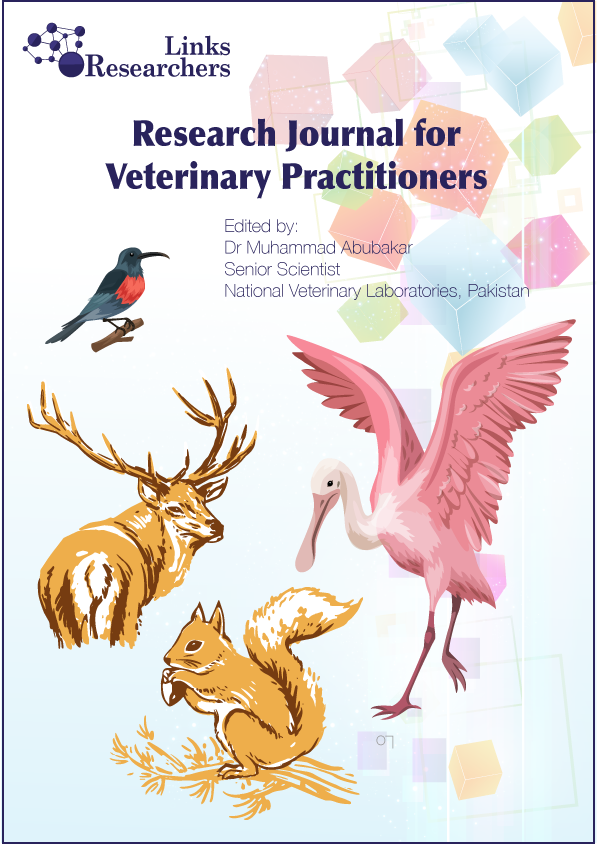Ahmed Sultan Jatoi1*, Shahid Mehmood2, Jibran Hussain2, Hafiz Muhammad Ishaq2, Yassar Abbas3, Muhammad Akram2
Muhammad Mushtaq, Umer Sadique, Naila Chand, Iftikhar Ahmed, Said Sajjad Ali Shah, Ijaz Ahmad, Imran Ullah and Muqadar Shah
Muhammad Afzal1 and Murad Khan2*
Erum Bughio1, Ahmed Sultan Jatoi*1, Muzamil Memon2, Reema Bughio3, Pervez Ahmed Khoso4, Zafar Ali Khoso1 and Ali Asghar Baloch5
Mahmoud Said1*, Abd El Satar Arafa1, Mohammed A. Rohaim2* and Hussein A. Hussein2
Furukh Faiz1,2, Muhammad Issa Khan2, Masood Sadiq2 and Haq Nawaz3
Rabia Tahir1*, Khushi Muhammad1, Masood Rabbani1, Muti-u-Rehman Khan2, Farah Khan1, Hassan Bin Aslam1 and Arslan Mehboob3
Javid Iqbal, Asghar Ali Mian, Tanveer Ahmad*, Shamsul Hassan** and Sohail Hassan Khan*
Nihal Ahmad Hadi, Shahid Ali* and Umer Wahid
Shahid Ali1* and Salamat Ali2
...
Murad Khan1* and Muhammad Afzal2
Ihsan Ali1#, Asim Aslam1*, Habib-ur-Rehman2, Beenish Zahid3, Ishtiaq Ahmed1
B were challenged with AI virus (H9N2) on 21 day of age, group B and C were
treated with 3% FO while group A and D were treated with cooking oil. For isolation
of virus, 21 samples were collected, out of which 8 (40%) were positive for H9. The
virus titer was ranged from 1:64 to 1:512. The body weight gain of FO
supplemented broilers was ...
Muhamamd Naeem1 and Murad Khan2*
Muqader Shah1,*, Hafsa Zaneb2, Saima Masood2, Rifat Ullah Khan1, Salahud Din1, Shakirullah3, Imad Khan2, Ambrina Tariq4 and Habib ur Rehman5
Ragia S. Mohamed1, Rania F. El Naggar2, Mamdouh. M. Hamoud1, Mohamed M. Hamoud3, Abdulrhman M. Gamal1, Samah E. Laban1, Shimaa A.E. Nasr1, Manal M. Zaki1, ElShaimaa Ismael1, Osama K. Zahran1*
Fady Samir1, Rania F. El Naggar2, Mohamed M. Hamoud3, Manal M. Zaki1, Abdulrhman M. Gamal1, Samah E. Laban1, Shaimaa A. E. Nasr1, El Shaimaa Ismael1, Osama K. Zahran1*
Erum Bughio1, Ahmed Sultan Jatoi1*, Jibran Hussain2, Muhammad Hayat Jaspal3, Shahid Mehmood2, Hafiz Muhammad Ishaq4, Reema Bughio5 and Athar Mahmud2
Mohsin Ali Alias Mehran Khan Solangi1, Gulfam Ali Mughal1, Asad Ali Khaskheli1*, Turab Ali Korejo3, Nazeer Ahmed Rajput2, Qurban Ali Memon3 and Maqsood Ahmed Kumbhar4
Mian Muhammad Arif* and Malik Muhammad Shafi
Amir M. Walaa1 ; Ausama Yousif1; Walid H. Kilany2; Magdy El-Sayed1; Ahmed A. El-Sanousi1
Ola Youssef 1; EL-Deeb A.H.2 Nassif S.A.1 and Ahmed A. El-Sanousi 2.
Hanaa A. Elsamadony1, Laila A. Tantawy1, Sabry E. Omar2 and Heba A. Abd Alah1
Theophilus Miebi Gbigbi* and Rodney Akpoviri Isiorhovoja
Ahmed M. Elbaz*, Engy F. Zaki, Morsy A. S.
Anguara Khatun1*, Sachchidananda Das Chowdhury1, Bibek Chandra Roy2, S.M. Shafikul Gani3, Bipul Chandra Ray1, Tanvir Ahmed1
Muhammad Khubaib Hameed, Muhammad Aziz ur Rahman, Muhammad Ashraf, Safdar Hassan, Muhammad Riaz, Muhammad Qamar Bilal, Fawwad Ahmad, Muhammad Sharif*
Ho Le Quynh Chau, Than Thi Thanh Tra, Duong Thi Huong, Du Thanh Hang, Le Thi Thu Hang, Vo Thi Minh Tam, Dinh Van Dung*, Ho Trung Thong
Syed Haseeb Ahmed Shah, Irfan Shahzad Sheikh, Abdul Samad, Muhammad Kamran Taj, Mohammad Masood Tariq*, Majed Rafeeq, Sumaira Fazal, Niamatullah Kakar, Sabeera Afzal and Asadullah
Mirza Lena1,2, Dinda Fathia Syahramadani2, Alfi Nurrachma Gustya2, Arif Darmawan2,3, Sumiati2, Wiwin Winarsih4, Minoru Maeda5, Komang Gede Wiryawan2*
Sajjad Khan*, Naila Chand, Abdul Hafeez, Nazir Ahmad
El-Kholy KH1, Tag El-Din H1, Tawfeek FA2, Sara HM Hassab1*
Keywords | Phytogenic, Hyperthermia, Endocrine hormones, Productive tr...
Rafiqul Islam1, Nasrin Sultana1*, Md. Abu Hadi Noor Ali Khan2
Taiwo Oladoye Akande*, Dayo Johnson Ogunyemi, Priscilla Funmilola Okunlola, Emmanuel Owolabi, Odetayo Olakanmi
Jumshaid Iqbal1, Muhammad Sharif1*, Muhammad Nadeem Suleman2, Muhammad Saeed3, Fawwad Ahamd1, Asghar Ali kamboh4, Tugay Ayaşan5 and Muhammad Arslan3
Lopamudra Samantaray*, Yashaswi Nayak
Muhamad Khairul Riza, Valentinus Priyo Bintoro, Sri Kismiyati, Sugiharto Sugiharto*
Hany M.R. Elsherif1, Ahmed Orabi2, Hussein M.A. Hassan3, Ahmed Samy3*
Ziaul Islam1*, Asad Sultan1, Sar Zamin Khan1 and Sher Bahader Khan2
Rahmat Ullah Khan1*, Asif Sadam2, Karim Gabol1, Waheed Ali Panhwar3, Sajid Mahmood4, Mustafa Kamal5, Hamid Ullah6, Syed Abidullah7, Muhammad Tufail8, Bashir Ahmad4, Gul Bacha Khan4 and Habib Ul Hassan1
Muhammad Furqan and Zulfiqar Ali
Ahmed A. Mohammed1, Madeha H. A. Darwish1, Eman A.A. Negm2, Ayman S. Abdel- Maguid3
Zannatul Ferdous1, Abdul Goffar Sarder2, Mustasim Famous3*, Mahfuza Ferdous4, Shahabuddin Ahmed5 and Md. Amir Hossain6
Sarzamin Khan1, Abdul Jabbar Tanweer2, Rafiullah1, Ibrahimullah1, Ghulam Abbas3*, Jabbar Khan4, Muhammad Saeed Imran5, Asghar Ali Kamboh6
Reem M. Ramadan1, Fady Sayed Youssef2, Gehad Genidy Mohamed3, Sameh Hamed Ismail4, M.M. El-Bahy1, Shimaa Abdel-Radi1*
Midrar Ullah1, Nail Chand2, Abdul Kabir3, Muhammad Rasheed4, Hubdar Ali Kaleri5, Saqib Kakar5, Mubarak Ali4, Deepesh Kumar6, Asad Ali Shah1, Amir Shahb1, Muhammad Amir Khan1, Raza Ali Mangi7, Abdul Wahid Solangi5, Rameez Kaleri5,8*
Sekobane Daniel Kolobe, Tlou Grace Manyelo*, Jones Wilfred Ng’ambi, Munyadziwa Felicia Dorcus Nemauluma, Emmanuel Malematja
Ahmed H. Abed1, Ahmed Orabi2*, Wafaa Hassan3, , Enas Hammad4 , Ghada Gaber5
Tlou Grace Manyelo1,2, Nthabiseng Amenda Sebola1, Jones Wilfred Ng’ambi2, Monnye Mabelebele1*
Hemat A. Abdel Magied*, Heba H. Habib, Amany H. Waly, Ahmed Fadl, Sayed M. Shalash
Sugiharto Sugiharto*, Ikania Agusetyaningsih, Endang Widiastuti, Hanny Indrat Wahyuni, Turrini Yudiarti, Tri Agus Sartono
Reda Hassan*, Bahaa Abou-shehema, Sherif Zayed, Micheal Gorgy, Shama Morsy, El-Sayed Abu El-Hassan, Mahmoud El-Gbaly, Hanaa Basuony, Ebtehal Hassan
Andi Tenri Bau Astuti Mahmud1, Lellah Rahim2, Muhammad Ihsan Andi Dagong2*, Sri Rachma Aprilita Bugiwati2, Wempie Pakiding2
Farhana Binte Zalal, Prodip Kumar Sarkar*, Mahbuba Sultana, M H Kawsar, Swapon Kumar Fouzder
Soshe Ahmed1*, Mst. Ishrat Zerin Moni1, Maksuda Begum2, Md. Jafar Eqbal3, Md. Shahidul Islam4, Mst. Samira Tanjim1, Mst. Rokeya Sultana1
Ayesha Bakhtiar1, Sardar Azhar Mehmood2, Abdul Rauf Bhatti3*, Shabir Ahmad2, Naqash Khalid2, Javed Iqbal5, Azra Nadeem4 and Waqas Ahmad1
Sri Setyaningrum*, Dini Julia Sari Siregar, Tengku Gilang Pradana
Ahmed Ali Chandio1, Asghar Ali Kamboh1*, Nazar Ali Korejo2, Riaz Ahmed Leghari3 and Muhammad Ali Chandio4
Saad Zaghlou El-Damrawy1, Reda Ali Hassan2*, Ahmed Maher Bakhaty1, Adel M. Nasr2, El-Sayed A. Abu El-Hassan2
Muhammad Arshad Iqbal*, Aamir Ghafoor, Irfan Ahmad, Muhammad Ijaz
Keatisak Soisuwan1, Hatairat Plaimast2, Atichat Thongnum3, Soranot Chotnipat4, Manatsanun Nopparatmaitree4*
Md Tariqul Islam1,5 *, Aditya Chowdhury Avi1,5, Md Saiful Bari2,5, Most Rebeka Sultana Swapna Khandoker3, Homaira Pervin Heema4, Goutam Buddha Das1
Nguyen Thi Anh Thu1*, Ly Thi Thu Lan1, Nguyen Thuy Linh1, Chau Cong Dang1, Nguyen Hoang Phuc1, Tran Dinh Tuan1, Nguyen Trong Ngu2
Fuji Astuty Auza1*, Sri Purwanti2, Jasmal A. Syamsu2, Asmuddin Natsir2, Rusli Badaruddin1, Deki Zulkarnain1, La Ode Muh. Munadi1
Yoshio Hamano1*, Yasuji Kurimoto2
Murat Durmus* and Hasan Rüstü Kutlu
Bayanda Mdoda*, Faith Machabi, Busisani Wiseman Lembede, Eliton Chivandi
Shafqat Ullah1, Asad Ullah2*, Imad Khan2, Rafiq Ullah1, Raheela Taj3, Fatima Syed3, Shumaila Gul4, Faiza Khan5, Ibad Ullah Jan6, Muneeb Islam7 and Sumaira8
Raed Hussein Salih Rabee1, Yahya Sabah Abdulameer1, Walla Farhan Obed1, Noor R Abady1, Adnan Mansour Jasim1*, Firas Hussein Albawi1, Mohammed Jasim Jawad2, Ahmed Samir Abukhomra3
Afshan1, Asad Ullah2*, Imad Khan2, Rafiq Ullah1, Tahira Tayyab1, Fatima Syed3, Raheela Taj3, Shumaila Gul4, Faiza Khan5, Ibad Ullah Jan6, Syed Weqas Ali7 and Assad Ullah8
Turrini Yudiarti*, Sugiharto Sugiharto, Endang Widiastuti, Hanny Indrat Wahyuni, Tri Agus Sartono, Maulana Hamonangan Nasution
Maria Endo Mahata1*, Yose Rizal1, Zurmiati1, Sepri Reski1, Indah Fitri Sakinah Limbong2, Dian Saputri2
Madbouly*, H.M.; Saif**, M.A. and Hussein* , A.S.
Madboulyl , H. M.; Tamami , S.M.; Abd Elmoneml , A.S.; Husseinl , A.S. and Arafa2, A.M.
Abd El-Razakl, A.G. and AboElkhair2, M.
*Hanan M.M. Elzahed, Abd EL-Moneim A.A, *Afaf A. Khedr, *Elham A. Elabiare, Waleed S. Abd El-Latif, Reda M.I.
Farid S. Nassar1,2, Osama A. El-Sayed3, Saidi Ouassaf4, Ahmed O. Abbas1,2*
Sajjad Khan*, Naila Chand, Abdul Hafeez and Nazir Ahmad
Irfan Ullah1, Asad Ullah2*, Tahira Tayyeb1, Rafiq Ullah1, Muhammad Hanif1, Faiza Khan3, Imad Khan2, Raheela Taj4, Fatima Syed4, Shumaila Gul5, Muhammad Sadeeq6, Muneeb Islam7, Arsalan Khan8 and Khudija Ghani9
Wahid Hussein El-Dabae*, Eman Shafeek Ibrahim, Eslam Gaber Sadek, Mai Mohamed Kandil
Rahib Ali Chachar1, Asghar Ali Kamboh1* and Manatbai Bakhetgul2
Hashim Hadi Al-Jebory1*, Mohammed Khalil Ibrahim Al-Saeedi2, Majeed Ajafar1, Nihad Abdul-Lateef Ali1
ZUBIA RASHID1, ZULFIQAR ALI MIRANI2, SITWAT ZEHRA1, SYED MUDDASSAR HUSSAIN GILANI3, ARIF ALI CHISHTI1, ABID AZHAR1 & SADDIA GALANI1*
Safdar Hassan1, Shaukat Ali Bhatti1, Fawwad Ahmad1, Asad Ullah Hyder1, Muhammad Arslan2, Ashar Mehfooz3, Ijaz Saleem3, Muhammad Umar Yaqoob4,5, Mushrraf Nazir1, Muhammad Sharif1*
Minh Thi Le Bui1, Thanh Minh Le2, Thuan Khanh Nguyen1*













